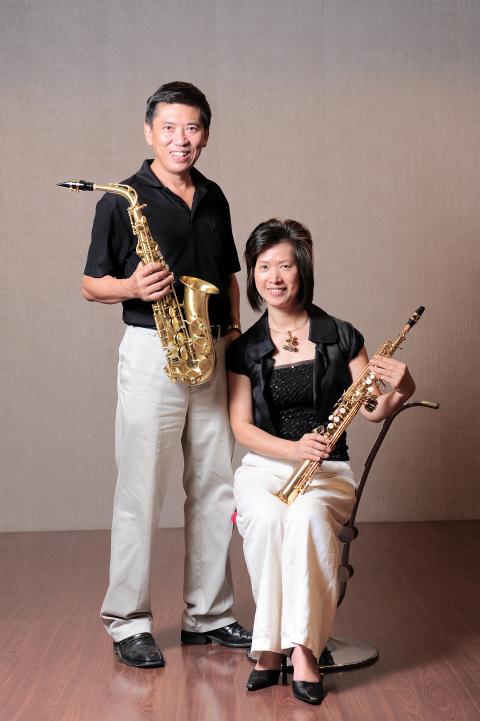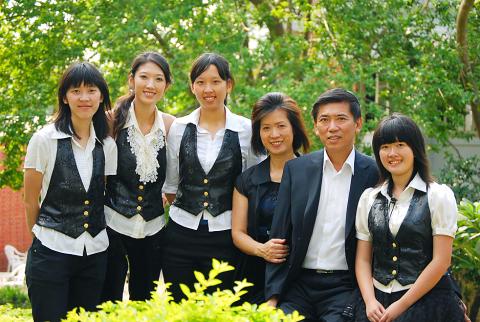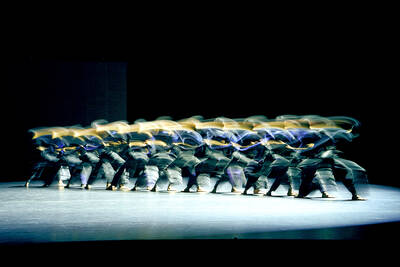Chang Tsung-yao’s (張宗瑤) future was pretty much determined at the moment of birth. When it came time for the Taiwanese custom of sitting the four-month-old in front of several objects so that he might choose his own destiny, there was actually only one item placed before him.
“My grandfather made me grab a saxophone,” quips Chang. “They even took photos as proof.”
Asked if he ever considered doing anything else his reply is quick, and alludes to a deep sense of family loyalty as well as a hefty set of expectations placed on his shoulders. “Not a chance,” he states. “My father wouldn’t allow it.”

Photo courtesy of Lien-Cheng Saxophone Company
Chang Tsung-yao is the third generation of the Chang family to take over Lien-Cheng Saxophone Company (張連昌薩克斯風), a business that his grandfather started nearly 70 years ago.
BUILDING FROM SCRATCH
Chang Lien-cheng (張連昌), Chang Tsung-yao’s grandfather, built his first saxophone in the mid-1940s. His work was based on the design of a Japanese sax, that of a friend whom he played in a jazz ensemble with. When the Japanese instrument was rendered unplayable by a house fire, the Chang patriarch decided to rebuild it out of bare necessity — no one in the group could afford to buy a new one, and without a saxophone the band’s continued existence looked grim.

Photo courtesy of Lien-Cheng Saxophone Company
The process of restoring the damaged saxophone took three years of painstaking work. Chang Lien-cheng was blinded in one eye by a flying piece of metal at one point, and had to put the saxophone together using scrap materials. But the finished product eventually sold for a price that was enough to bankroll the start of the company.
Though it got off to a fairly auspicious start, the company has gone through its share of ups and downs over the years. The 1980s saw several Taiwanese instrument manufacturers pull up stakes and relocate to China for its lower production costs.
MADE IN TAIWAN
The Lien-Cheng Saxophone Company was one of the few that remained in Taiwan, and transformed itself from making saxophones purely for other well-known brands from overseas to promoting its own unique made-in-Taiwan brand.
The company also held to its family-run business ideals, choosing to keep day-to-day operations entirely within the Chang clan. This came to include Chang Tsung-yao’s wife, Wang Tsai-jui (王彩蕊), who now manages the business alongside her husband. For Wang, it was a steep learning curve.
“I started out knowing nothing about [the company] and became an expert,” Wang says proudly. “I’ve learned everything from manufacturing to promoting and selling.”
But not everyone is so eager to take up the trade with the same enthusiasm that Wang and Chang Tsung-yao have displayed — a fact which could bode ill for the future of the business.
TRICKS OF THE TRADE
Whereas Chang Tsung-yao has become an authority on manufacturing and assembling each of a saxophone’s 400-odd parts, he says that young people today are less willing to enter into an apprenticeship that sees them start at the bottom and work their way up slowly as he was made to by his father.
“Most of the young people nowadays don’t like to do factory work,” he says. “But making saxophones requires high-level skills to achieve the elegant look and beautiful sound.”
Fortunately for the company, Chang and Wang have four daughters anxious to help out. These up-and-coming executives have not only embraced the business end of the family heritage, but the artistic side as well.
OLD HABITS DIE HARD
Each plays a different variety of saxophone, and they perform together as a quartet. But according to their father, he still has a bottom line to consider, and although he respects his daughters’ abilities, he says he owes it to his grandfather’s legacy to do what is best for the business. So will the company, which has been passed down for generations from father to son, eventually be taken over by one of Chang Tsung-yao’s daughters?
The second-youngest of the four, Chang Yu-fang (張瑜峰), has no reservations about continuing the family business.
“I grew up surrounded by the music of the saxophone, and the sounds of making saxophones,” she says. “It’s the most familiar sound and the most comfortable environment for me, so I will take over my father’s business one day.”

Most heroes are remembered for the battles they fought. Taiwan’s Black Bat Squadron is remembered for flying into Chinese airspace 838 times between 1953 and 1967, and for the 148 men whose sacrifice bought the intelligence that kept Taiwan secure. Two-thirds of the squadron died carrying out missions most people wouldn’t learn about for another 40 years. The squadron lost 15 aircraft and 148 crew members over those 14 years, making it the deadliest unit in Taiwan’s military history by casualty rate. They flew at night, often at low altitudes, straight into some of the most heavily defended airspace in Asia.

Many people in Taiwan first learned about universal basic income (UBI) — the idea that the government should provide regular, no-strings-attached payments to each citizen — in 2019. While seeking the Democratic nomination for the 2020 US presidential election, Andrew Yang, a politician of Taiwanese descent, said that, if elected, he’d institute a UBI of US$1,000 per month to “get the economic boot off of people’s throats, allowing them to lift their heads up, breathe, and get excited for the future.” His campaign petered out, but the concept of UBI hasn’t gone away. Throughout the industrialized world, there are fears that

Like much in the world today, theater has experienced major disruptions over the six years since COVID-19. The pandemic, the war in Ukraine and social media have created a new normal of geopolitical and information uncertainty, and the performing arts are not immune to these effects. “Ten years ago people wanted to come to the theater to engage with important issues, but now the Internet allows them to engage with those issues powerfully and immediately,” said Faith Tan, programming director of the Esplanade in Singapore, speaking last week in Japan. “One reaction to unpredictability has been a renewed emphasis on

Taiwan’s democracy is at risk. Be very alarmed. This is not a drill. The current constitutional crisis progressed slowly, then suddenly. Political tensions, partisan hostility and emotions are all running high right when cool heads and calm negotiation are most needed. Oxford defines brinkmanship as: “The art or practice of pursuing a dangerous policy to the limits of safety before stopping, especially in politics.” It says the term comes from a quote from a 1956 Cold War interview with then-American Secretary of State John Foster Dulles, when he said: ‘The ability to get to the verge without getting into the war is